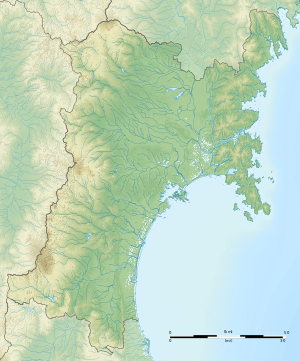Mutsu Kokubun-niji
| Mutsu Kokubun-niji | |
|---|---|
| 陸奥国分尼寺 | |
|
Mutsu Kokubun-niji Hondo | |
 Shown within Miyagi Prefecture  Mutsu Kokubun-niji (Japan) | |
| Basic information | |
| Location | 33-26 Shirahagi-cho, Wakabayashi-ku, Sendai-shi, Miyagi-ken |
| Geographic coordinates | 38°15′3.97″N 140°54′34.28″E / 38.2511028°N 140.9095222°ECoordinates: 38°15′3.97″N 140°54′34.28″E / 38.2511028°N 140.9095222°E |
| Affiliation | Buddhist |
| Deity | Kannon Bostasu |
| Rite | Sōtō |
| Country | Japan |
| Status | active |
| Architectural description | |
| Founder | Emperor Shōmu |
| Completed | 741 |
Mutsu Kokubun-niji (陸奥国分尼寺) is a Buddhist temple in Wakabayashi-ku, Sendai, Japan, belonging to the Sōtō Zen sect, and is the provincial convent ("kokubun-niji") of former Mutsu Province. The grounds of the temple are a National Historic Site.[1]
History
The Shoku Nihongi records that in 741, as the country recovered from a smallpox epidemic, Emperor Shōmu ordered that a monastery and convent be established in every province, the kokubunji (国分寺).[2][3]
In the late Nara period, after the establishment of a centralized government under the Ritsuryō system, the Yamato court sent a number of military expeditions to what is now the Tōhoku region of northern Japan to bring the local Emishi tribes under its control.[4] After the establishment of Taga Castle, Yamato forces gradually pushed into the hinterland of what is now Miyagi Prefecture, establishing several fortified settlements along with several large-scale Buddhist temples. The Mutsu Kokubun niji was located approximately 700 meter east of the Mutsu Kokubun-ji and 10 kilometers from Taga Castle. The original design of the temple is unknown, but excavations in 1964 revealed the foundation stones of at least eight structures, along with roof tiles and fragments of Sue ware pottery.
The temple was destroyed and rebuilt on several occasions, and its written records have been lost.
It was rebuilt in 1570 as a Sōtō sect monastery on a small scale, but not upon the original foundations.
See also
References
- ↑ "陸奥国分尼寺跡 むつこくぶんにじあと". Cultural Heritage Online (in Japanese). Agency for Cultural Affairs. Retrieved 25 December 2016.
- ↑ Brown, Delmer M. (1993). Cambridge History of Japan vol. I. Cambridge University Press. p. 255.
- ↑ Yiengpruksawan, Mimi Hall (1998). Hiraizumi: Buddhist Art and Regional Politics in Twelfth-Century Japan. Harvard University Press. pp. 22f.
- ↑ Shively, Donald H.; McCullough, William H. (1999). Cambridge History of Japan vol. II (p.31f.). Cambridge University Press.
External links
| Wikimedia Commons has media related to Mutsu Kokubun-niji. |